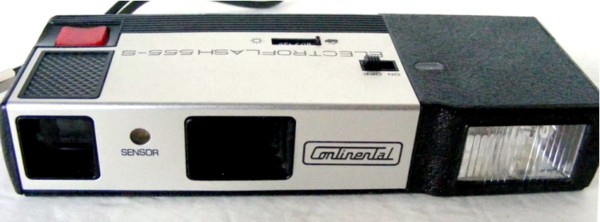
CONTINENTAL 110 CAMERAS

Continental sold several 110 cameras. They didn't actually make any other them, and they may have come from different camera manufacturers -- and they were also sold under other labels/brand names.
If you are able to provide more accurate information than is listed here, please contact us.
The baby brother of the 555 S (below), it retains most of its features, such as the built-in flash controlled by a sensor on the front. Uses 2 AA batteries.
The camera has the classic rectangular bar form-factor you find on many low end 110 cameras. The front of the camera has, from left-to-right; an opening for the viewfinder, marking "Optical Lens 1:8", the recessed lens opening, the Continental logo, and a built in flash. Uses 2 AA batteries.
It's exactly the same as the 555 Electroflash, but can accept 100 or 400 speed film, and adds a sensor to indicate if a flash is needed. The front of the camera has, from left-to-right; an opening for the viewfinder, small window labeled "sensor", the recessed lens opening, the Continental logo, and a built in flash. On the top there is a red shutter release button, a textured finger grip area. Centered is a sliding switch with a sun icon, and sun behind the clouds pictogram. The slider has 400 (when slid towards sun) and 80/125 (when slid towards cloudy) for film speed selection. When slid into the full sun side, it slides a neutral density filter between the lens and the shutter. The top also has a flash switch which is set to "ON" or "OFF." -- for the built-in flash. On the bottom there is a thumb winder typical of most 110 cameras, and a not-so-typical tripod socket. The right side has a battery door for the two AA batteries which power the flash and exposure system. The left side has a wrist strap lug. The rear has the eye side of the view finder and the film loading door. The shutter mechanism is cocked by the perforation sensor, so the camera will not accept non-perf reloads. The camera will accept 80/100 or 400 ASA. The sliding switch decreases the exposure for 400 using a neutral density filter. The exposure system will only tell you if there is enough light or not. A red LED in the viewfinder glows if there is not enough light -- turn the flash ON! The shutter is a strange configuration consisting of a flapping door between the lens and the film. The lens is a single element meniscus so don't expect great results. This camera is not a very sophisticated imaging machine, however, it is adaptable to a pretty wide variety of photographic situations. A step up from a simple point and shoot…but not a very big step.
Built-in flash. Uses 2 AA batteries.
Built-in flash. Uses 2 AA batteries.
Built-in flash. Uses 2 AA batteries.
The Powerwinder series of three cameras came with a built-in autowinder. The big brother of the 555 S (above), The 950S adds in a built-in autowinder in the same body. All-weather design. Uses 2 AA batteries.
This model has a built-in flash (with an ON/OFF switch on the end), and a switchable normal and telephoto lens (with an NORMAL/TELE switch on the top). It has a rather nice hinging battery door. It was available in a all black body or one with a gray band across the top. Uses 2 AA batteries.
Top of the Powerwind line. Uses 2 AA batteries.
(1981) It is a more sophisticated 555 S Electroflash. It has a built-in flash, but unlike the 555 S, the flash does not have an ON/OFF switch. Instead, the sensor on the front of the camera determines when the flash is needed, and automatically charges and triggers the flash. It has the sensor of the 555 S, but the 600 SF sensor is coupled to the function of the flash instead of requiring a separate switch to turn the flash on and off. Also, it does not have the multi-film speed selector of the 555 S, which inserts an ND filter for fast film -- the camera is optimized for 400 speed film with a cassette sensor in the film chamber. Also it has the telephoto lens arrangement of the 1000T and 350T. It has a dual-lens "telephoto" function, which allows you to choose from a standard lens and a longer focal length lens. The switch actually changes the entire lens block from one lens to another, rather than just sliding a second lens element over the standard lens. The viewfinder has a red perimeter frame that slides into place when the lens is put in the "telephoto" position, which limits the view to a smaller area to replicate the approximate view of the telephoto lens.
This model has a built-in flash and switchable normal and telephoto lens. Uses 2 AA batteries.
This model has a built-in flash and switchable normal and telephoto lens. It has a flash ON/OFF switch and a flash-ready light.
This model has a fast, f5.6 lens, built-in flash and switchable normal and telephoto lens. It has a flash ON/OFF switch and a flash-ready light.

To return to the main index for the Sub Club click here.
COPYRIGHT @ 1995-2024 by Joe McGloin. All Rights Reserved.